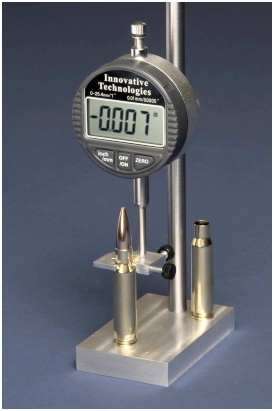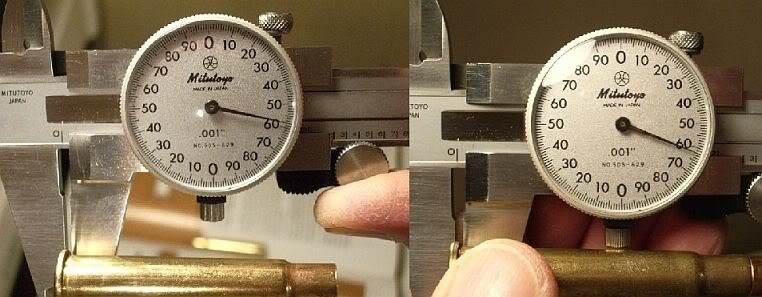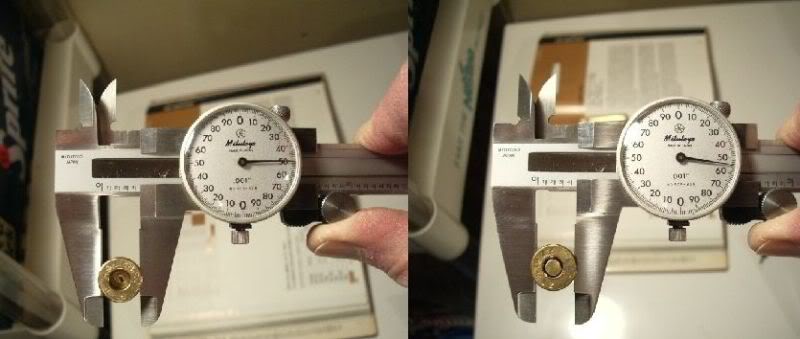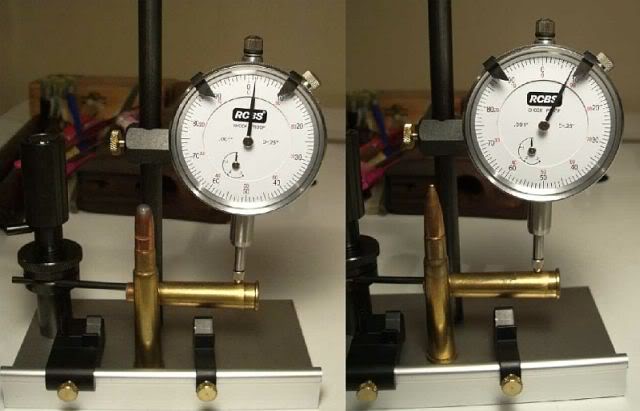-
Headspace on an M1917
Hi all, sorry if we're going over old ground but, I've just bought an M1917 in 7.62(an old range rifle), the barrel is excellent but when I check the headspace(with the bolt body stripped) the bolt won't close completely but it will close far enough for the rifle to discharge (even on the field gauge). So does this mean the rifle has excessive headspace? The rifle is registered as a .308 winchester and those are the gauges I'm using, but here in Australia 7.62 Nato and .308 Win are generally considered synonymous. Would the possible difference in chambering perhaps be the culprit, or is the headspace just excessive?
7.62 Nato and .308 Win are generally considered synonymous. Would the possible difference in chambering perhaps be the culprit, or is the headspace just excessive?
Is the only simple rectification a selectively fitted bolt body, or relief of the barrel tennon and shoulder and screwing the barrel in a little more(possible quite easily due to the lack of fixed sights on the barrel).
Thanks and sorry for my ignorance, it's my first 1917.
(I don't know how to move a post either)
Information
 |
Warning: This is a relatively older thread
This discussion is older than 360 days. Some information contained in it may no longer be current. |
|
-
-
08-09-2010 08:58 AM
# ADS
Friends and Sponsors

-
The bolt locking surfaces are of the interrupted thread type, but of very fine pitch, so if it won't close all the way you're fine! (Final closing cam leverage using these lugs is about 100:1 (!!!))
-
-
-
Banned

tbonesmith
Even the European CIP the sister to the American SAAMI, states the .308 and 7.62 NATO are the same cartridge. In actuality the .308 Winchestre has LOWER chamber pressure than the 7.62 NATO, BUT the real difference is military chambers and headspace are larger.
Below is a photo of an American made headspace gauge set made for the .308/7.62 and the are made in .001 increments and you can see nine gauges.
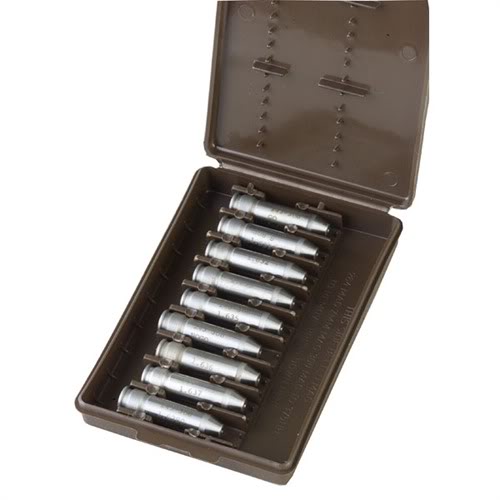
Forget your headspace gauges for a moment and do a little test of your M1917, you will need a new empty unfired .308 case, a spent fired primer and a pair of vernier calipers.
What you are going to check with this is how far or how much a primer seated in your rifle by closing the bolt on this test cartridge is sticking out the rear of the cartridge. In simple terms you are checking head gap clearance or how much "air space" is between the rear of the case and the bolt face.
I don't have any .308 photos so I'm using the .303 case as an example here.
1. First measure the length of the unfired 308 case and write this measumrnt down.
2. Now start and partially seat the spent primer in the primer pocket.
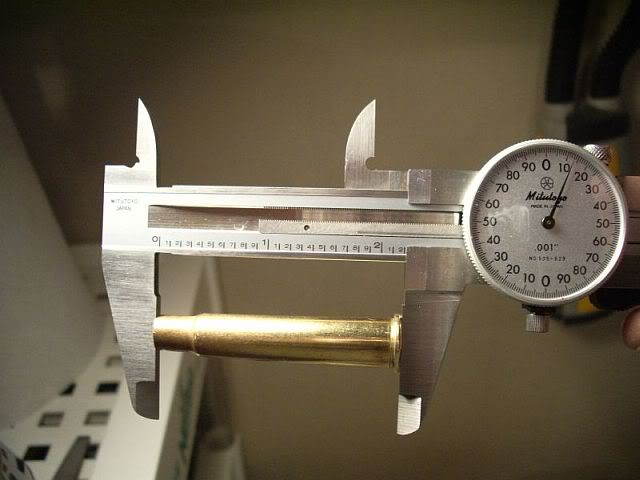
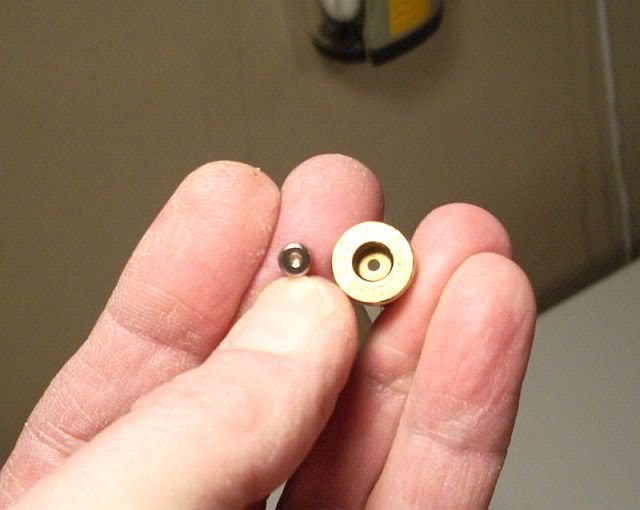
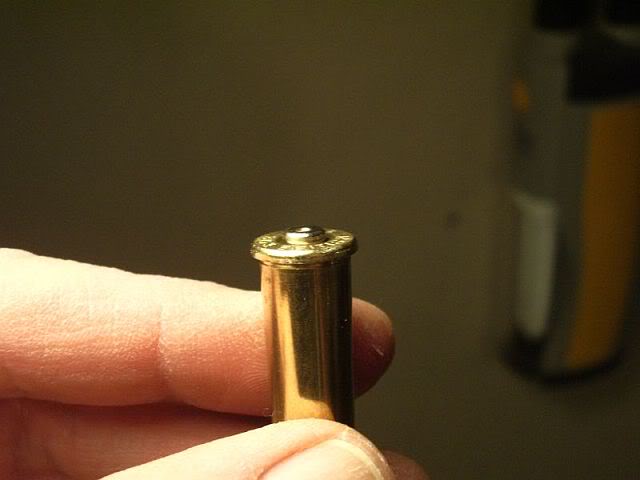
Now slowly and carefully close the bolt on this test cartridge fully and seat the primer, remove the case and remeasure the case and write this down also.
Now subtract the first case measurement from your second case measurement and this will tell you your head gap clearance.
NOTE: The American M14 7.62 NATO rifle can have .009 head gap clearance and still pass the field gauge test.
7.62 NATO rifle can have .009 head gap clearance and still pass the field gauge test.
Below is a example of a .303 Winchester case fired in my Enfield Rifle with the headspace set at .067, my head gap clearance was .009 (nine thousandths) and the case stretched .009 when fired.
with the headspace set at .067, my head gap clearance was .009 (nine thousandths) and the case stretched .009 when fired.
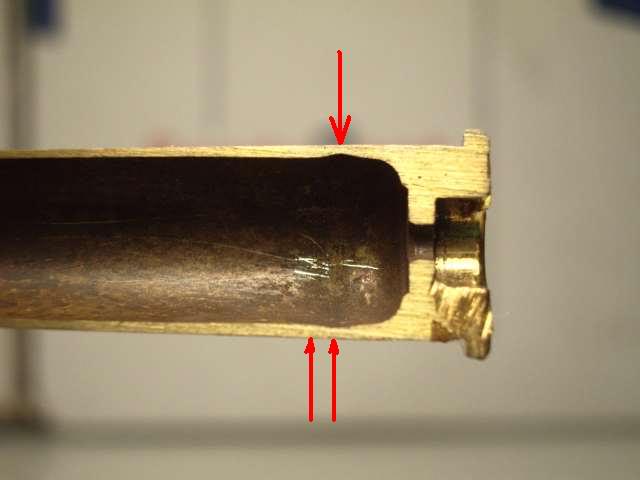
The average commercial case is made .002 shorter than minimum headspace for a given rifle caliber to ensure the cartridge will fit in the chamber. If you subtract .002 from your case measurements and and this to the minimum headspace requirement you will have your actual headspace reading.
I "cheated" and didn't buy headspace gauges for my 7.62 Ishapore 2A1, I purchased a RCBS Precision Mic and did the above testing with the unfired case as a "gauge".
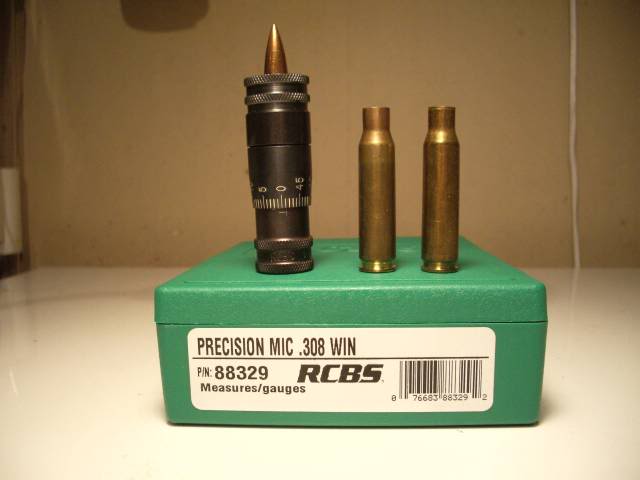
Below, minimum headspace for the .308.

Below the actual case measures .002 shorter or .002 less than minimum headspace for the .308 Winchester.
Now also remember this, each country sets its own headspace limits for the 7.62 Nato and as an example the British L42 Enfield has tighter headspace settings than American commercial SAAMI standards. (.002 tighter than even the British L1A1)
L42 Enfield has tighter headspace settings than American commercial SAAMI standards. (.002 tighter than even the British L1A1)
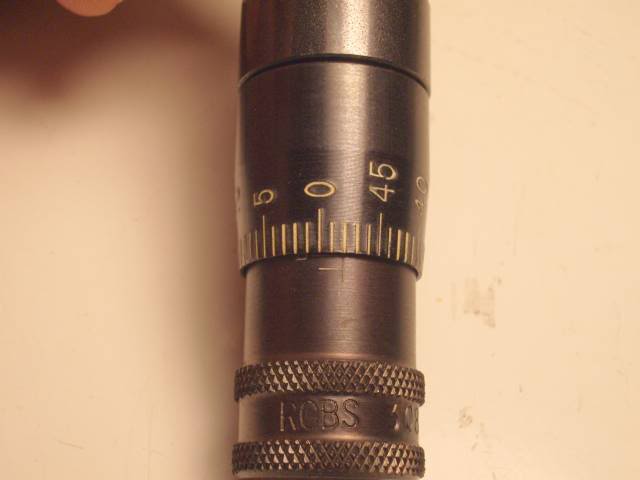
If your test cartridge primer extends .002 to approximately .006 you are in commercial headspace range, if it is .011 or less you are in military headspace range. On my Ishapore 2A1 I have .007 thousandths head gap clearance which puts it in the safe headspace range for the M14 rifle.
Remember it is the head gap clearance or the "air space" behind the case that causes case stretching and case head separations, and military case are made thicker in the base web area to prevent excessive case stretching in military firearms.
Below an example of excess head gap clearance for the .303 British (over .020)

-
FREE MEMBER
NO Posting or PM's Allowed

tbonesmith .......
.......
Ed did a great job of showing several important things that can help you out. The backed out primer shows a fired case with excessive headspace. The case gripped the chamber wall, and it allowed the primer to back out. Great photography . . . . worth lots of words.
He also showed the RCBS Precision Mic. I prefer to use the Digital Headspace Gauge because it works on ALL calibers, and it does the job of other reloading tools.
Whether you're loading a .303 Brit. (or a .308 Win.) you should also measure chamber clearance "at the shoulder". Ed's cut-in-half case shows the result when a fired case stretches too far to fill the chamber. This case stretching thins (and weakens) the brass above the web, and it causes headspace separations.
I use the Digital Headspace Gauge to compare my handloads (at the shoulder) to my fired cases. That's the best way for handloads to fit reliably and get the longest case life.
If you're not installing barrels (and if you reload), you really have no need for conventional headspace gauges.
-
Advisory Panel


i dissagree, anyone that collects, and shoots vintage rifles, most that are well over 65 years old...should have a No Go and Field reject, and should check them now and then.
SMLE, Savage 99. Winchester 94,s 1917,s and P14,s are known for headspace issues.
iv repaired many of these rifles, that if the shooters had and knew how to check headspace, and look for signs of bad headspace on a fired case, they would have not failed.
any time i buy a used Milsurp...the first thing that is done, is a cleaning rod run down the tube....second...headspace is checked... set of gages cost is less then 50.00...and a cheap way of keeping your rifles safe...
i just worked on a new model Savage 99, in .308 Win, that had less then 500 round shot through it...wouldnt eject a handloaded case.
never thought that rifle being as new would have headspace issues.. so i worked the extractor... well, the extractor worked so well, it pulled the rim off.
i checked headspace....it failed no go and field reject.. a new barrel is on the way. no...i wont turn back the shoulder on a lever action rifle to repair headspace.
Last edited by Chuckindenver; 08-19-2010 at 10:07 AM.
-
-
Banned

-
Advisory Panel


i agree, a fired case is your best way of checking headspace... but to tell these guys, to not use a headspace gage or have them checked by a gunsmith,,is almost criminal.
NEVER EVER SHOOT A SURPLUS RIFLE WITHOUT HAVING IT CHECKED BY A GUNSMITH ever...some of these rifle saw hard use., and likely got no service before being sold as surplus.
some exeperianced shooters may have gages, and may be able to do the safety check themselvs.. for less then what the tooling cost that you have pictured a set of headspace gages can be purchased.. like for half the amount.
many of the posters here are first time buyers of military rifles, and take what is said here as the bible....when starting out collecting and shooting these rifles, picking up a set of gages for each cal,. you shoot is a great idea, some gages can be used for other cal, as well, .308. 243. .260 use the same gage. 25.06 30-06, and others use the same gage..
even if you just use a No Go..its better then nothing..
imagine what would happen if someone new to collecting, got a french Mas, with some ammo, took it to the range, and just fired it without checking the headspace first,,,and it had a case head failure, then loosing an eye, cuts and bruses,,and a damaged rifle...
when if he had just spent 50.00 and got a no go gage, he would have already known it may fail.....
i do agree with what your saying,,,but safety first...always check the headspace on these old rifles before you fire them..
you have about 500.00 or more worth of measuring tools pictured,...how many shooters do you think have those,?? 10% maybe..?
500.00 can buy alot of headspace gages....
Last edited by Chuckindenver; 08-20-2010 at 09:35 PM.
-
-
Banned

chuckindenver
Why would I want to take my Ishapore 2A/2A1 7.62 Enfield to a gunsmith to have the headspace checked when even a American gunsmith wouldn't know the correct headspace settings for this Indian made rifle.
So anyone please show me the Indian manual for the Ishapore 2A/2A1 7.62 Enfield Rifle and the correct headspace settings.
and the correct headspace settings.
Don't bother looking, you won't find the Indian manual and a American gunsmith would just use the gauges for the M14 rifle and be wrong.
rifle and be wrong.
BUT with a spent primer and a unfired case you could find out your head gap clearance and not waste your money taking your Ishapore 2A/2A1 to a gunsmith who doesn't have any idea what the headspace settings are.
-
Advisory Panel


my posts wernt a flame, no need to take it personal, im only trying to steer you in a direction..when giving advise on these and other forums..you always must assume the worse.
i agree with just about everything you said, cept for not checking headspace.
some of the readers here are experianced shooters, and have a good grasp on how this all works, but some have no idea, and tend to take this to heart...
i try and give the most simple, safest help i can give..
-
-
Advisory Panel


Chuck, Ed, I respect you both for your knowledge, and don't like to see you unnecessarily working each other up into a lather. I therefore propose the following compromise - which I thinks covers both your positions:
If you know that your rifle WAS actually manufactured to CIP or SAAMI standards, then it is a very good idea to check the headspace with the appropriate set of gauges.
If it was NOT, I suggest you follow Ed's method, as it allows you to sort out the "possibles" from the "hopeless" quickly and cheaply.
To avoid even touching the fringes of the Enfield headspace minefield, I suggest you take a look at the Carl Gustav, a.k.a. Swedish Mauser. We are fortunate in having a real expert on these forums, known as "Dutchman", who has covered the headspace topic re. Carl Gustav in convincing detail. Look it his website.
Mauser. We are fortunate in having a real expert on these forums, known as "Dutchman", who has covered the headspace topic re. Carl Gustav in convincing detail. Look it his website.
If you take a perfect Carl Gustav to a gunsmith and he pops in SAAMI gauges, he will tell you that the rifle fails the test.
The rifle is fine, but the gauges are wrong for a rifle that was NOT made to SAAMI standards.
Patrick
-
7.62 Nato and .308 Win are generally considered synonymous. Would the possible difference in chambering perhaps be the culprit, or is the headspace just excessive?


















 PM
PM















